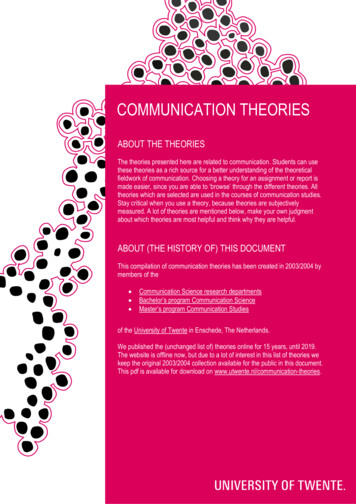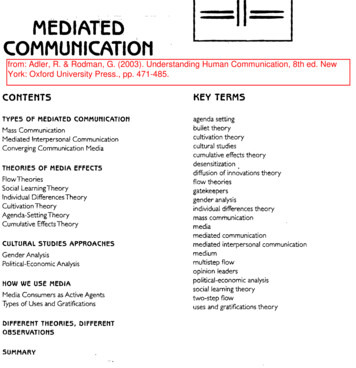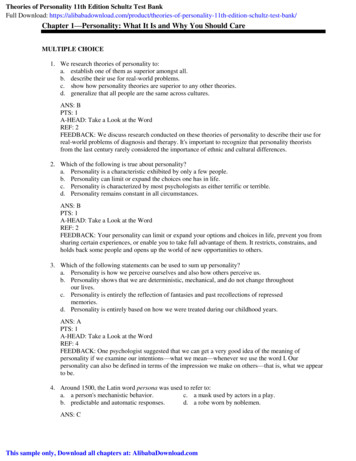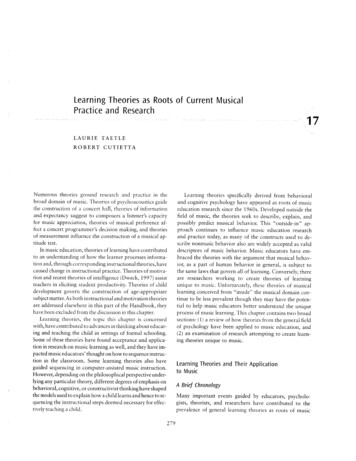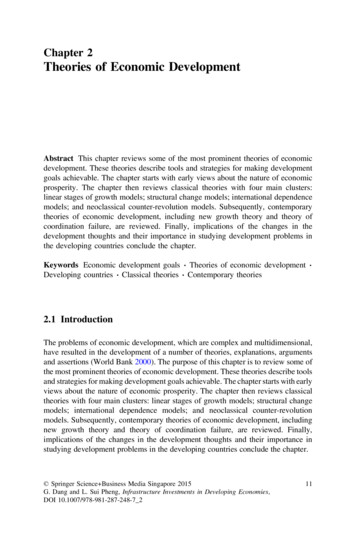
Transcription
Chapter 2Theories of Economic DevelopmentAbstract This chapter reviews some of the most prominent theories of economicdevelopment. These theories describe tools and strategies for making developmentgoals achievable. The chapter starts with early views about the nature of economicprosperity. The chapter then reviews classical theories with four main clusters:linear stages of growth models; structural change models; international dependencemodels; and neoclassical counter-revolution models. Subsequently, contemporarytheories of economic development, including new growth theory and theory ofcoordination failure, are reviewed. Finally, implications of the changes in thedevelopment thoughts and their importance in studying development problems inthe developing countries conclude the chapter. Keywords Economic development goals Theories of economic developmentDeveloping countries Classical theories Contemporary theories 2.1 IntroductionThe problems of economic development, which are complex and multidimensional,have resulted in the development of a number of theories, explanations, argumentsand assertions (World Bank 2000). The purpose of this chapter is to review some ofthe most prominent theories of economic development. These theories describe toolsand strategies for making development goals achievable. The chapter starts with earlyviews about the nature of economic prosperity. The chapter then reviews classicaltheories with four main clusters: linear stages of growth models; structural changemodels; international dependence models; and neoclassical counter-revolutionmodels. Subsequently, contemporary theories of economic development, includingnew growth theory and theory of coordination failure, are reviewed. Finally,implications of the changes in the development thoughts and their importance instudying development problems in the developing countries conclude the chapter. Springer Science Business Media Singapore 2015G. Dang and L. Sui Pheng, Infrastructure Investments in Developing Economies,DOI 10.1007/978-981-287-248-7 211
122 Theories of Economic Development2.2 Goals of Economic Development2.2.1 Growth of Gross National ProductThe goal of economic development in its simplest form is to create the wealth of anation. Prior to the 1970s, rapid economic growth has been considered a goodproxy for other attributes of development (Todaro and Smith 2009). Economicperformance is measured by an annual increase in gross national product (GNP1)[an alternative measure is gross domestic product (GDP)]. For the purpose ofcomparability, GNP is expressed in a common currency, usually US dollars, andreported in per-capita terms to take into account the size of a nation’s population(Jaffee 1998). The World Bank now replaces GNP per capita with gross nationalincome (GNI) per capita to compare wealth among countries. The World Bankdefines GNI as the sum of value added by all resident producers plus any producttaxes (less subsidies) not included in the valuation of output plus net receipts ofprimary income (compensation of employees and property income) from abroad.Meanwhile, the World Bank still uses GDP in many other featured economicindicators (World Bank 2011).However, the indicator is a measure of well-being and development exclusivelybased on material wealth. Improvements in welfare such as better health care,education and more housing for large parts of the poor population have not beencaptured. The experience of the 1950s and 1960s has shown that GNP growthwould not necessarily result in a better life for a nation’s population. The narrowgoal of development (economic growth) induced nations to focus their energiesnarrowly on the rapid growth of national incomes (Todaro and Smith 2003). “Tomaximize income growth, environmental considerations were left to languish on thesidelines; the standard of living was often allowed to slide; large inequalitiesbetween classes, regions, and genders were ignored; and poverty was toleratedmore than it should have been in the rush to generate maximum growth” (Basu2000, p. 64). It was then scholars and policy-makers in most developing countrieswho realized that income growth was only one dimension of development; a neweconomic view of development has arrived.2.2.2 Quality of LifeDuring the 1970s, the concern of millions of people living subsistence lives inpoverty turned the attention of development economists to people’s lives rather thantheir incomes. Many developing countries have experienced high growth rates of1GNP is gross domestic product (GDP) plus incomes received by residents from abroad minusincomes claimed by non-residents. GDP is calculated as the value of the total final output of allgoods and services produced in a single year within a country’s boundaries (Soubbotina 2004).
2.2 Goals of Economic Development13per-capita income but little change in the living conditions of a large part of thepopulation. By questioning whether it is the goal of development that per-capitaincome increases but poverty, inequality and unemployment are growing worse,Seers (1969) marked the change needed in setting development objectives. The goalof development during the period was thus not limited to economic growth but toconcentrate on the reduction of poverty, inequality and unemployment (Seers 1979).In the 1990s, economists increasingly recognized that it was the quality of life thatdetermines whether people are from developing countries or not. Diseases, malnourishment and death that happen in the everyday lives of those from the developing countries changed the view of development goals dramatically. By then, likemany scholars around the world, Stiglitz (1998) contributed to shift the developmentgoals set by governments in developing countries to wider objectives, includingimprovements in income distribution, environment, health and education. A broaderperspective of development goals is hence necessary as reflected in the World Bank’sDevelopment Report (1991, p. 4) as “to improve the quality of life. Especially, in theworld’s poor countries, a better quality of life generally calls for higher incomes—but it involves much more. It encompasses as ends in themselves better education,higher standards of health and nutrition, less poverty, a cleaner environment, moreequality of opportunity, greater individual freedom, and a richer cultural life.”Sen’s (1985, 1992, 1999) work perhaps has brought about the broadest perspective of development goals. According to Sen (1985), the ultimate goal ofdevelopment is to enhance human capabilities, which is defined as “the freedomthat a person has in terms of the choice of functionings, given his personal features(conversion of characteristics into functionings) and his command over commodities ” (Sen 1985, p. 13). Higher income is necessary but not sufficient in terms ofquality of life. Under his approach, goals of economic development change frompromotion of growth to promotion of well-being.These changes in the definition of development goals posed the need to constructalternative composite indices to reflect quality of life. These indices should take intoaccount not only money indicators but also non-monetary indicators to reflect thedevelopment levels achieved. There have been attempts to build indicators thatmeasure the standard of living and quality of life, which focus on the quantitativeand qualitative aspects: health, education, environment and material well-being(Berenger and Verdier-Chouchane 2007). Using Sen’s (1985) approach, the HumanDevelopment Index (HDI) has been published annually since 1990 by the UnitedNations Development Programme as an attempt to provide an aggregate measure oflife expectancy, education and income (Elkan 1995).2.2.3 Sustainable DevelopmentIncreasingly, academics and societies realize the effects of human actions on theenvironment. On the way to achieve rapid economic growth, countries around theworld have been exploiting their natural resource reserves at alarming rates.
142 Theories of Economic DevelopmentAlthough early economists included the natural environment in their economicanalysis, environmentalism only drew international attention in the 1960s (Pearceand Turner 1990). The relationship between development and environment hasgiven birth to the sustainable development concept. The central idea of sustainabledevelopment is that global ecosystems and humanity itself can be threatened byneglecting the environment.Environmental economists are concerned that the long-term neglect of theenvironmental assets is likely to jeopardize the durability of economic growth(Thampapillai 2002). Sustainable development therefore “involves maximizing thenet benefits of economic development, subject to maintaining the services andquality of natural resources over time” (Pearce and Turner 1990, p. 24). Its concernis about balancing the objectives of economic growth and attending to environmental considerations.In a broader sense, sustainable development is defined by the BrundtlandCommission, formally the World Commission on Environment and Development,as “progress that meets the needs of the present without compromising the ability offuture generations to meet their own needs” (World Commission on Environmentand Development 1987, p. 8). Although this standard definition brings the term“sustainable development” into common use, it has created ambiguity in application(Redclift 1992; Daly 1996; Payne and Raiborn 2001). Much of the debate aroundthe definition seeks to answer the two questions “What should be sustained” and“What should be developed” (Kates et al. 2008).Today, sustainable development aims to improve the quality of life in a comprehensive manner, including economic prosperity, social equity and environmentalprotection. Economic, social, environmental and cultural aspects must be integratedin a harmonious manner to enhance the intergenerational well-being (World Bank2003).2.2.4 The Millennium Development GoalsEight Millennium Development Goals (MDGs) were adopted by member countries ofthe United Nations in September 2000. The MDGs were developed to address themost pressing problems in developing countries, including poverty and hunger, primary universal education, gender equality, child health, maternal health, HIV/AIDS,environmental sustainability and global partnership. Member countries of the UnitedNations have committed themselves to end poverty and achieve other developmentgoals by 2015. Quantitative targets of these goals were then assigned based on the pastrates of international development achievements (United Nations 2011).However, the MDGs were criticized for failing to include other critical objectives of development, such as improving legal and human rights of the poor,slowing global warming and leveraging the contributions of the private sector.Critics also argued that the MDG targets were not ambitious enough and were notprioritized (Todaro and Smith 2009).
2.2 Goals of Economic Development15The latest 2012 report showed a remarkable progress made by countries,including those in sub-Saharan Africa. The review maintained that the MDGs arestill achievable. Increased supports from national governments, the internationalcommunity, civil society and the private sector are considered necessary to meet theMDGs (United Nations 2012).2.3 The Evolution of Economic Development Thoughts2.3.1 Early Views About the Nature of Economic Societyand ProsperityAlthough development economics became established as a discipline within economics only in the 1950s, several early economists had written extensively about thenature of economic society and prosperity. Among them, Adam Smith and Karl Marxare the two most famous thinkers for their two opposite views on the nation’s systemof economic arrangements: one called capitalism and the other called socialism.On the one hand, Adam Smith’s (1976) (original work published in 1776) “TheWealth of Nations” focuses on the market. Adam Smith saw that division of labourcould create more productive processes. The mechanism for enhancing the nation’swealth therefore is through specialization and exchange. Adam Smith argued thatunder competition, private investors while pursuing their own interests guided bythe “invisible hand” would maximize national output and thus promote publicinterests. The “invisible hand” doctrine has become the foundation for the workingof the market economy or capitalism (Skousen 2007). In the system, governmentinterference is seen as inefficient in looking after economic activities. Meanwhile,free trade, private property and competition are seen as the foundations that wouldspur economic development, reduce poverty and bring on social and moralimprovements of humankind. However, freewheeling capitalism is often criticizedfor bringing wealth only to the rich, whereas the poor get poorer.On the other hand, Karl Marx in “Capital” (Marx 1933) (original work publishedin 1867) argued that the feasible system should be based on social or publicownership of property. Karl Marx emphasized that the wealth of the capitalistscomes from the exploitation of the surplus value created by the workers. Hence,private property and free market were seen as causes of poverty for the manymillions of workers. Therefore, private property should be completely abolished. Anation’s economy should be planned and managed by the state to serve the interestsof the masses. Marx believed that a revolution would be inevitable to break downthe increasing concentration of the capitalists, and to establish socialism (Roemer1988; Skousen 2007). But the socialism philosophy was not viable either. Thehistorical experience of socialist economies showed little or even no improvementin the living conditions of the poor. The collapse of the Soviet Union in 1991 andthe central planning paradigm appeared to demonstrate that the model would notprovide the solution to poverty and inequality seen in human society (Meier 2000).
162 Theories of Economic Development2.3.2 Classical Theories of Economic Development2.3.2.1 The Linear Stages of Growth ModelsThe first generation of economic development models was formulated in the earlyyears after the World War II. These early models focused on the utility of massiveinjections of capital to achieve rapid GDP growth rates. The two famous models areRostow’s stages growth model and the Harrod–Domar model (Todaro and Smith2009).Theorists of the 1950s and early 1960s viewed the process of development as asequence of historical stages. This view was popularized by Rostow (Ingham1995). Building on the historical pattern of the then developed countries, Rostow(1960) claimed that the transition from underdevelopment to development wouldpass through five stages: the traditional society, the preconditions for take-off, thetake-off, the drive to maturity and the age of high mass consumption. The decisivestage is the take-off, through which developing countries are expected to transitfrom an underdeveloped to a developed state. Increasing rate of investments isconsidered to be necessary to induce per-capita growth. Like Rostow’s stagesgrowth model, the Harrod–Domar model emphasized that the prime mover of theeconomy is investments (Ghatak 2003). Every country therefore needs capital togenerate investments. The principal strategies of development from the stageapproach were commonly used by developing countries in the early post-war years.With a target growth rate, the required saving rate can then be known. If domesticsavings were not sufficient, foreign savings would be mobilized.Although Rostow (1960), Harrod (1948) and Domar (1947) were right about theimportant role of investments that is most closely correlated with the economicgrowth rate, this is not the only condition for a country to develop. The key weaknessof these models lies in their simplifying assumptions. A single production function issimply assumed for all countries (Adelman 2000). Every economy is assumed tohave the same necessary conditions and would pass through the same phasing, stageby stage. But that economic growth path, which historically had been followed by themore developed countries, is not the only one pathway. The development process isactually highly nonlinear (Chenery 1960; Chenery and Syrquin 1975). Countriesmay pursue distinct development paths (Morris and Adelman 1988). Economies maymiss stages, or become locked in one particular stage, or even regress depending onmany other complementary factors such as managerial capacities, and the availabilityof skilled labour for a wide range of development projects (Todaro and Smith 2009).2.3.2.2 Structural Change ModelsDuring most of the 1960s and early 1970s, economists generally described thedevelopment process as structural change by which the reallocation of labour from theagricultural sector to the industrial sector is considered the key source for economicgrowth. Two well-known representatives of this approach are the two-sector
2.3 The Evolution of Economic Development Thoughts17model (Lewis 1954), and the structural change and patterns of development (Chenery1960).In Lewis’ (1954) two-sector model or theory of surplus labour, labour increasingly moves away from the agricultural sector to the industrial sector. However, withunlimited supply of labour from the traditional sector, these transferred workerscontinually received only subsistence wages. The excess of modern sector profitsover wages and hence investments in the modern sector continued to expand andgenerate further economic growth on the assumption that all profits would bereinvested. Both labour transfer and modern sector employment growth were in turnbrought about by output expansion in that sector. This process of modern sector selfsustaining growth and employment expansion facilitated the structural transformation from a traditional subsistence economy to a more modern developed economyto take place. Like the Harrod–Domar model, the Lewis model considered savingsand investments to be the driving forces of economic development but in the contextof the less developed countries. However, several Lewis’ assumptions are not validsuch as those relating to rural surplus labour, and the proportional rate of expansionin capital accumulation in the modern sector (Todaro and Smith 2009).Although promoting the roles of savings and investments, the structural changeand patterns of development analysis extended in comparison with the Lewis model.The analysis identified that the steady accumulation of physical and human capital isamong conditions necessary for economic growth, apart from savings and investments. Moreover, the structural changes occurred not only in the two sectors but alsoin all economic functions, including the change in consumer demand from anemphasis on food and basic necessities to desires for diverse manufactured goods andservices, international trade and resource use as well as changes in socioeconomicfactors such as urbanization and the growth and distribution of a country’s population.The most significant explanation of this approach was provided by Chenery (1960),Chenery and Taylor (1968), Kuznets (1971) and Chenery and Syrquin (1975).By focusing on the pattern of development rather than theory, the structural changemodels may mislead policy-makers. Since the reallocation of labour from the agricultural sector to the industrial sector is considered the engine of economic growth,many developing countries implemented policies that often promote the industry andneglect agriculture. But the negative effects of policies that turned against that vitalsector have come to be widely recognized (World Bank 2000). Criticisms of thesemodels were reinforced by the fact that in many developing countries, poverty wasprevalent. Following the pattern recommended by structural change economists, inthe late 1960s, the attention of policy-makers began to shift towards an emphasis onhuman capital, i.e. education and health (Meier 2000). Then again, investments inhealth and education alone do not guarantee development. “In Sub-Saharan Africa,for example, life expectancy and school enrolment rates have increased dramaticallyin recent decades, but as a group the economies in the region have had slow and evennegative growth since the early 1970s” (World Bank 2000, p. 16).The structural change models focused on the pattern of development andhypothesized that the pattern was similar in all countries and was identifiable.However, empirical works, such as Chenery (1960), Chenery and Taylor (1968),
182 Theories of Economic Developmentand Chenery and Syrquin (1975), on the process of structural change does recognize that pattern of development can be different among countries, which isdependent on the countries’ particular set of factors including “a country’s resourceendowment and size, its government’s policies and objectives, the availability ofexternal capital and technology, and the international trade environment” (Todaroand Smith 2009, p. 120).2.3.2.3 International Dependence ModelsThe international dependence theory was very popular in the 1970s and early 1980s.The dependence theorists argued that underdevelopment exists because of thedominance of developed countries and multinational corporations over developingcountries. The theory is considered an extension of Marxist theory (Hein 1992).The poor countries are said to be dependent on the developed countries formarket and capital. However, developing countries received a very small portion ofthe benefits that the dependent relationship brought about. The unequal exchange,in terms of trade against poor countries, made free trade a convenient vehicle of“exploitation” for the developed countries. Developed countries can exploitnational resources of developing countries through getting cheap supply of food andraw materials. Meanwhile, poor countries are unable to control the distribution ofthe value added to the products traded between themselves and the developedcountries (Cohen 1973; Dos Santos 1973). The growth of international capitalismand multinational corporations caused poor countries to be further exploited andmore dependent on the developed countries. Poor countries therefore could notexpect sustained growth from that dependence. Following the internationaldependence theory, developing countries should therefore end the dependence bybreaking up their relationships with the developed world, as well as by closing theirdoors on the developed countries (Elkan 1995; Ghatak 2003; Ferraro 2008).The models gained increasing support among the developing countries because ofthe limited results of the stages and structural change models. However, the failures ofthe model were clearly reflected in the developing countries that followed the autarkypolicy. These countries often experienced stagnant growth and finally decided to opentheir economies once again such as China, Tanzania and India (Ferraro 2008; Todaroand Smith 2009). Meanwhile, the experience of the newly industrialized economiesof East Asia, namely Hong Kong, Singapore, Taiwan and South Korea, during the1970s and 1980s showed that their success had been the result of emphasizingtrade with the advanced industrial countries. The negative impacts of the policy ofautarky rendered the theory out of favour in the 1980s (Hein 1992; Ferraro 2008).2.3.2.4 Neoclassical Counter-Revolution ModelsIn the 1980s, neoclassical counter-revolution economists used three approaches,namely the free market approach, the new political economy approach and the
2.3 The Evolution of Economic Development Thoughts19market-friendly approach, to counter the international dependence model. In contrast with the international dependence model, these approaches mainly argued thatunderdevelopment is not the result of the predatory activities of the developedcountries and the international agencies but was rather caused by the domesticissues arising from heavy state intervention such as poor resource allocation,government-induced price distortions and corruption (Meier 2000). As a responseto public sector inefficiency, economists of the counter-revolution thinking, forexample Bauer (1984), Lal (1983), Johnson (1971), and Little (1982), focused onpromoting free markets, eliminating government-imposed distortions associatedwith protectionism, subsidies and public ownership.Another strand of neoclassical free market thoughts called the traditional neoclassical growth theory actually originated from the Harrod–Domar and Solowmodels. Expanding the Harrod–Domar formulation, Solow neoclassical growthmodel stresses the importance of three factors of output growth: increases in labourquantity and quality (through population growth and education), increases in capital(through savings and investments) and improvements in technology (Solow 1956).Technological change in Solow’s model is provided exogenously. Thus, with thesame provided rate of technological progress, the growth rate would be expected toconverge across countries. By opening up national markets, developing countriescan draw additional domestic and foreign investments, thus increasing the rate ofcapital accumulation and returns on investments. Consequently, developing countries tend to converge to higher per-capita income levels (World Bank 2000).Neoclassical economists focused on the market to find a way out for thedeveloping countries. Policies of liberalization, stabilization and privatizationtherefore become the central elements of the national development agenda. Foreigntrade, private international investments and foreign aid flowing into the developingcountries are expected to accelerate economic efficiency and economic growth ofthese countries. Empirically, the models, however, did not bring about the expectedresults. The growth rates per capita have diverged among countries (Azariadis andDrazen 1990). Several African countries focusing on these issues achieved anaverage growth rate of only 0.5 % per year. With weak and inadequate legal andregulatory framework, not to mention the different institutional, cultural and historical context of the developing countries, free market in these countries fails tostimulate economic development (World Bank 2000).2.3.3 Contemporary Theories of Economic Development2.3.3.1 New Growth TheoryEndogenous growth or the new growth theory emerged in the 1990s to explain thepoor performance of many less developed countries, which have implementedpolicies as prescribed in neoclassical theories. Unlike the Solow model that considers technological change as an exogenous factor, the new growth model notes
202 Theories of Economic Developmentthat technological change has not been equal nor has it been exogenously transmitted in most developing countries (World Bank 2000).New growth theorists (Romer 1986; Lucas 1988; Aghion and Howitt 1992)linked the technological change to the production of knowledge. The new growththeory emphasizes that economic growth results from increasing returns to the useof knowledge rather than labour and capital. The theory argues that the higher rateof returns as expected in the Solow model is greatly eroded by lower levels ofcomplementary investments in human capital (education), infrastructure, orresearch and development (R&D). Meanwhile, knowledge is different from othereconomic goods because of its possibility to grow boundlessly. Knowledge orinnovation can be reused at zero additional cost. Investments in knowledge creationtherefore can bring about sustained growth. Moreover, the knowledge could createthe spillover benefits to other firms once they obtained the knowledge. However,markets failed to produce enough knowledge because individuals cannot capture allof the gains associated with creating new knowledge by their own investments.Policy intervention is thus considered necessary to influence growth in the longterm. The new growth models therefore promote the role of government and publicpolicies in complementary investments in human capital formation and theencouragement of foreign private investments in knowledge-intensive industriessuch as computer software and telecommunications (Meier 2000).Although the new growth theory helps to explain the divergence in growth ratesacross economies, it was criticized for overlooking the importance of social andinstitutional structures (Skott and Auerbach 1995). Its limited applicability lies in itsassumptions. For example, it treats the economy as a single firm that does notpermit the crucial growth-generating reallocation of labour and capital within theeconomy during the process of structural change. Moreover, there are many otherfactors which provide the incentives for economic growth that developing countrieslack such as poor infrastructure, inadequate institutional structures and imperfectcapital and goods markets (Cornwall and Cornwall 1994). Policy-makers willtherefore need to pay careful attention to all of the factors that determine thechanges and their impacts on the aggregate growth rate.2.3.3.2 Theory of Coordination FailureThe foundation of the theory of coordination failure is the idea that the market mayfail to achieve coordination among complementary activities. When complementaries exist, that is when returns of one investment depend on the presence or extent ofother investments, there exist two scenarios. On the one hand, optimally, all investorsas a whole are better off with all investments to be achieved at the same time. On theother hand, it would not make sense for an investor to take similar actions when hebelieves that others may not do the same as well. The market is said to have failed tocoordinate investors’ actions in this way. Coordination failure therefore leads themarket to an (equilibrium) outcome inferior to a potential situation in which
2.3 The Evolution of Economic Development Thoughts21resources would be optimally allocated and a
The goal of economic development in its simplest form is to create the wealth of a nation. Prior to the 1970s, rapid economic growth has been considered a good proxy for other attributes of development (Todaro and Smith 2009). Economic performance is measured by an annual increase in gross national product (GNP1)



